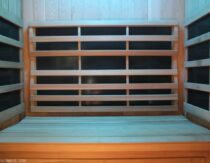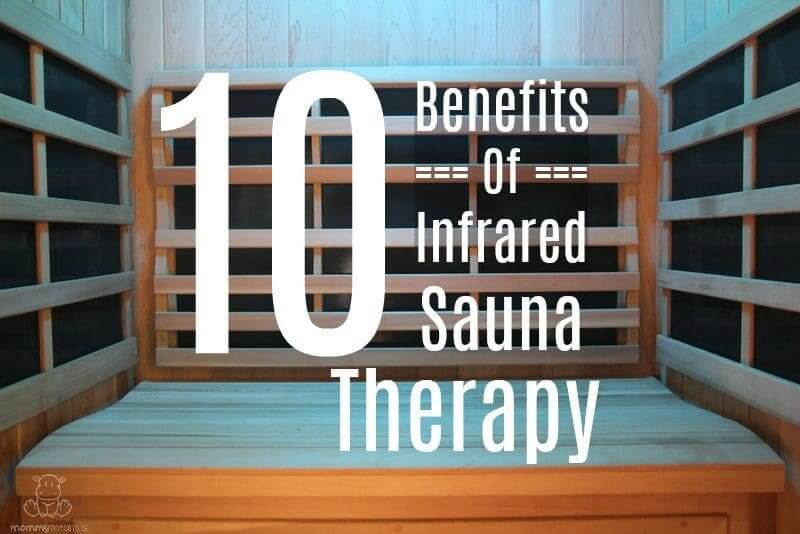
I’ve been getting a lot of questions lately about whether or not I still love sauna therapy and use mine regularly, or if it’s like an abandoned piece of exercise equipment gathering dust. The answer is I absolutely love my sauna, and I’ve updated this post with research that explains why.

Remember that time I shared a silly pic of my head popping out of a portable sauna? I’ve since upgraded to a full-spectrum infrared sauna, and in this post I’m going to share with you the reason I decided to put one in my home and use it nearly every day.
The short version: I am able to burn 500 calories, read a chapter to my littles (they like to visit), take my stress levels down 10 notches, support detoxification, activate heat-shock proteins associated with longevity, and think more clearly in just 30 minutes a day . . . all while sitting down. I feel AMAZING when I get out, and can’t wait to do it all over again.
- What is an infrared sauna?
- 10 Science-Back Sauna Benefits for Health & Well-Being
- 1. Increases Metabolism
- 2. Detoxifies Heavy Metals, BPA, PCB’s and other toxins
- 3. Gorgeous, Youthful Skin
- 4. Optimizes Your Biological Age
- 5. Relaxation & Stress Reduction
- 6. Soothes Sore Muscles
- 7. Benefits Cognitive Function
- 8. Supports Cardiovascular Health
- 9. Supports Immune Function
- 10. Increases Slow Wave Sleep
- Want to own a sauna?
The long version: There’s a lot of science supporting the physiological benefits of saunas, and that’s what we’re about to dive into. But first, you might be wondering…
What is an infrared sauna? ^
Infrared light, which we experience as heat, is the invisible part of the sun’s spectrum. Although we can’t see it, we can feel it in the warmth of sunshine on our skin. The far infrared wavelength – which is what I’ll be focusing on in this post – is highly beneficial, penetrating deeply into tissues to induce a detoxifying sweat.
It’s so safe it’s used to keep babies warm in the NICU, and our bodies radiate it naturally. (1) The warmth of a hug? Infrared heat. The gooey feeling you get when you hold hands? Not necessarily caused by infrared heat, but your hands do in fact emit about 8-10 microns of infrared.
Traditional wet and dry saunas use heated air to warm the body, which means they typically have to be uncomfortably hot to reach therapeutic levels. Infrared saunas, on the other hand, penetrate into tissues directly, causing the body to sweat at a more comfortable ambient temperature.
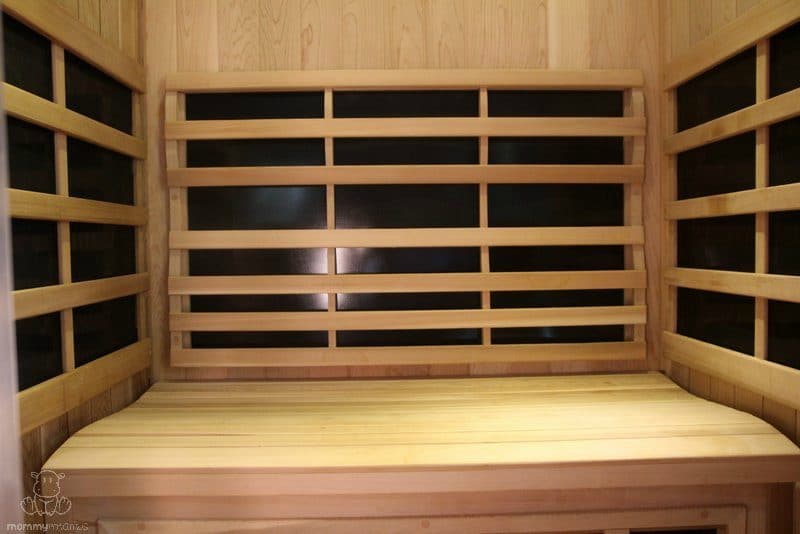
10 Science-Back Sauna Benefits for Health & Well-Being ^
But why is it so important to sweat? Here are nine reasons:
1. Increases Metabolism ^
Sauna therapy is sometimes called passive cardio because it raises your heart rate in a way that is similar to exercise, or as this Harvard article puts it, “the high temperatures can drive heart rates to levels often achieved by moderate-intensity physical exercise.”
A 30 minute session burns about 600 calories, says this article in the Journal of the American Medical Association, while this study published in the Canadian Journal of Diabetes found that patients receiving far-infrared sauna therapy showed “a trend toward decreased waist circumference.”
Does the time of day a sauna is used affect fat metabolism? Yep. A two-phase study conducted at Binghamton University says yes. When participants used an infrared sauna an average of three times a week, they lost up to 4% body fat in sixteen weeks. One unexpected result was that participants who used the sauna later in the day lost more weight, so they set up a second study to learn more.
In the follow up study, they found that people who used the sauna after 3pm lost the same amount as those in the first study, but in half the time.
They attribute the difference in weight loss results to lowered evening cortisol (which is how things should be if our hormones are balanced), and slightly increased levels of human growth hormone (HGH).
2. Detoxifies Heavy Metals, BPA, PCB’s and other toxins ^
Some people say that detoxing is silly because are bodies are perfectly capable of detoxing without help. While I agree that our bodies are amazing and we have powerful innate detox capabilities, the reality is that:
- The average person carries about 700 pollutants in their bodies at any given moment. Even babies are affected – a recent study found more than 200 chemicals in newborn cord blood alone. (2) (3)
- Companies are not required to study the long-term health effects of the majority of chemicals they produce, so most don’t. (3)
- An estimated 30-50% of the American population (myself included) has the MTHFR genetic mutation, which may impair detoxification
Expecting our bodies to manage those factors – in addition to naturally occurring heavy metals like lead and mercury – is like expecting a housekeeper to keep things spotless with a band of uninvited monkeys living in the house.
Our detoxification systems need support, and there are many ways to go about that. Dry brushing is one of my favorites, and the other is sauna therapy because:
- Sweat is therapeutic. In fact, it’s a major detoxification pathway. (4) More on that below.
- It requires very little effort on my part. All I need to do is take 20-40 minutes of time to sit and relax. One of my kids often joins me for about 15 minutes so that we can read a chapter from their current book, then I read my own book or just breathe in the aroma of warm cedar around me.
What’s in a drop of sweat?
According to Dr. Rhonda Patrick, who holds a PhD in biomedical science, sweat contains both hydrophyllic (water soluble) and lipophilic (fat soluble) components, making it an elimination pathway for a variety of toxins such as:
- Xenobiotics such as BPA (often absorbed through store receipts), PCB’s, and phthalates
- Arsenic, cadmium, lead, mercury
(Source: Sauna Use And Building Resilience to Stress – Also, here are some studies you can check out if you want to learn more : 4, 5, 6, 7)
One important note: Sweating also depletes electrolytes, so you’ll need to replace calcium, magnesium and potassium. I use my Coconut Lime Electrolyte Drink Recipe or just water with a generous pinch of sea salt. According to Dr. Patrick, kale is also a concentrated form of electrolytes, so you can put some in a smoothie after you sauna to replenish electrolytes as well.
3. Gorgeous, Youthful Skin ^
One of the most unexpected – and welcome – changes I noticed when I began using a sauna regularly is how much more refreshed and “glowy” I looked after a few months of use.
Far infrared wavelengths increase the production of collagen (which makes skin supple) and elastin (which makes it elastic), and also improves the delivery of nutrients to the skin via increased blood flow. (8)
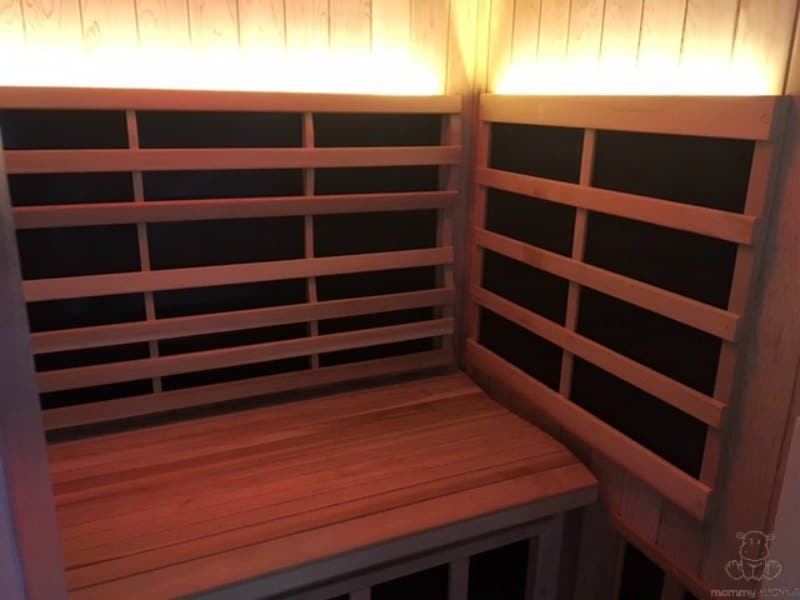
4. Optimizes Your Biological Age ^
We have two ages: Our chronological age (the actual time we’ve been alive) and our biological age (the rate at which we’re aging on a cellular level).
Most of us have all had the experience of being surprised to find out that someone is far younger than we had imagined — for instance, when an individual we thought was in their late 50s turns out to actually be in their mid-40s,” Dr. Terry Grossman, founder and medical director of the Grossman Wellness Center in Denver, explained for Everyday Health. “And, by the same token, we will occasionally discover that someone is considerably older than we had guessed. The reason for these discrepancies is often because their biological ages are different than their chronological ages.” (9)
So what makes our biological age older (or younger) than our chronological age? One big factor is the kind of stress in our lives.
Hormesis – The Good Kind of Stress
According to Dr. Rhonda Patrick, “Almost all the primary causes of aging have stress at their root. Inflammation is a prime example and in fact it’s been identified as one of the key drivers of the aging process . . . . However somewhat paradoxically, stress isn’t always bad. Short term stress can result in a reduction in long term chronic stress – in other words we can build resilience. This is because short-term exposure to stress can strengthen the cellular response mechanisms in the body to stress. This is called hormetic stress.”(10)
Exercise is a type of hormetic stress, as is cold stress and – you guessed it – heat stress. Sitting in a sauna creates heat stress, which causes the body to increase its production of heat shock proteins, which help repair damaged proteins and protect DNA.
Normally we produce fewer heat shock proteins as we age. However, some people have genetic mutations that cause them to maintain higher production. For example, Centenarians (people who live to be at least 100), tend to have an increased expression of heat shock proteins. (11)
It’s not just humans, either. In another study, researchers found that exposing C. elegans worms to sauna-like conditions – thus producing heat shock proteins – extended their lifespan by about 30%. (12)
For those of us who don’t naturally make high levels of heat shock proteins, sauna therapy can stimulate production. (13)
Also, the “longevity gene” – FOX03 – is also activated by heat. (14) Just like with heat shock proteins, people with a higher expression of FOX03 genes are more likely to live to 100. (15)
5. Relaxation & Stress Reduction ^
Regular sauna use has significant emotional health benefits for people living with chronic stress, too.
Unlike short-term stressful experiences – which produce a rise in cortisol and a physical response followed by a reduction in cortisol after the event – chronic stress often causes our bodies stay in “high alert” stage for hours, days and even sometimes months without a reset.
Since our bodies often can’t distinguish life-threatening situations (like running away from tiger) from non-critical situations (like running late to a non-essential appointment), they react to everything just in case. That’s a problem because:
When you repeatedly experience the mobilization or fight-or-flight stress response in your daily life, it can lead to serious health problems. Chronic stress disrupts nearly every system in your body. It can shut down your immune system, upset your digestive and reproductive systems, raise blood pressure, increase the risk of heart attack and stroke, speed up the aging process and leave you vulnerable to many mental and physical health problems.” (16)
Fortunately, it’s not necessary to renounce civilization and move into a yurt to reclaim relaxation. When your body gets stuck in stress mode you can manually reset it. Exercise is one way to do it – sauna therapy is another.
When you expose your body to heat stress, your cortisol level (an indicator of stress) will typically stay the same or even rise. However, when you remove the stress by stepping out of the sauna, it typically drops to a new baseline that is lower than before. Your body thinks the “tiger” is gone and has reset, leaving you feeling relaxed.
In addition to helping with stress, sauna therapy stimulates the release of “feel good” endorphins and neurotransmitters such as serotonin and dopamine, which is why I feel AMAZING when I finish a session. (17) (18)
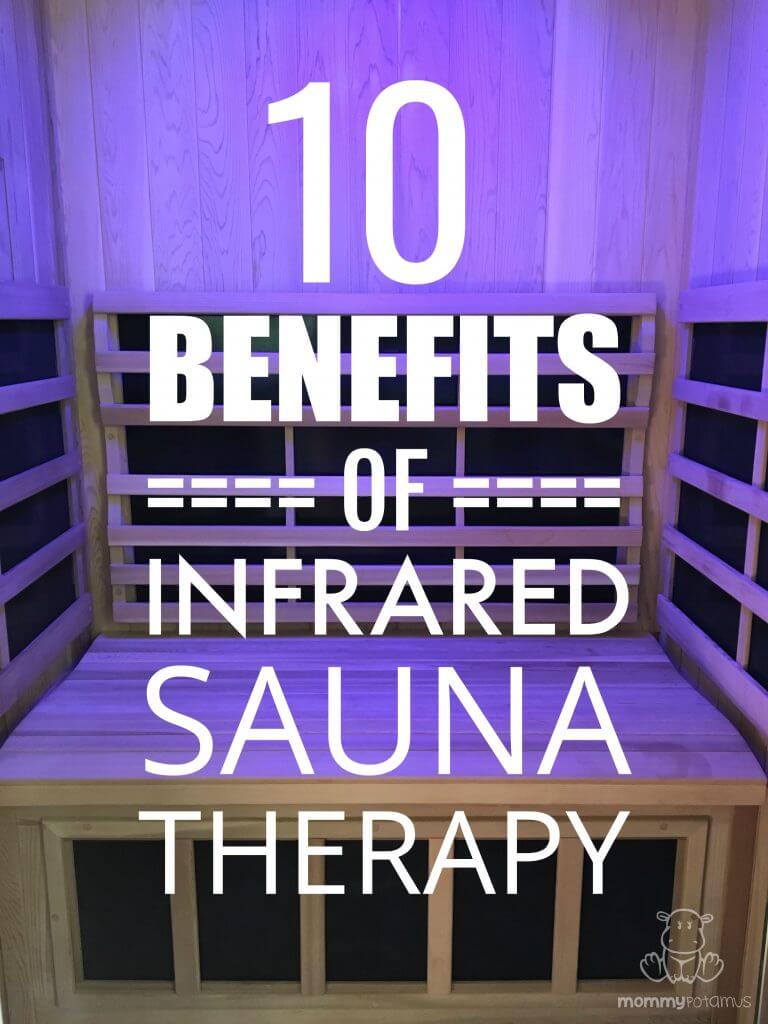
6. Soothes Sore Muscles ^
This is my husband’s favorite benefit. Soothing infrared heat penetrates into sore muscles and joints, increasing the flow of nutrients (glucose, amino acids, fatty acids, and oxygen) to the area while removing lactic acid and other metabolic byproducts.
7. Benefits Cognitive Function ^
Heat stress:
- Creates brain-derived neurotrophic factor (BDNF), which stimulates neurogenesis (the growth of new brain cells) and protects existing neurons from damage (19)
- Significantly increases norepinephrine levels, a hormone that supports focus and attention. (20)
8. Supports Cardiovascular Health ^
As I mentioned earlier, infrared sauna therapy is sometimes called “passive cardio” because, as this Harvard article puts it, “the high temperatures can drive heart rates to levels often achieved by moderate-intensity physical exercise.”
“The cardiovascular effects of sauna have been well documented in the past. It lowers blood pressure, and there is every reason to believe that its effects are good for blood vessels,” says Dr. Lee of Harvard-affiliated Brigham and Women’s Hospital. (21)
9. Supports Immune Function ^
According to Mark Timmerman, M.D. of the North American Sauna Society, “During a sauna session, white blood cells increase in the bloodstream, suggesting an elevation of the body’s natural defense against illness.”
10. Increases Slow Wave Sleep ^
According to this study, sauna bathing increases slow wave sleep, which is commonly referred to as deep sleep.

Warming up in my sauna. I recommend wearing a towel usually, but if you are going to post a photo on the internet cotton clothes are a good option, too 🙂
Want to own a sauna? ^
Remember that silly sauna pic I mentioned at the beginning? That was my first go at in-home sauna bathing. It served a purpose, but had some limitations.
Find out why I chose it in this article along with how to get hundreds of dollars off your order, plus a free ergonomic backrest and aromatherapy cup.
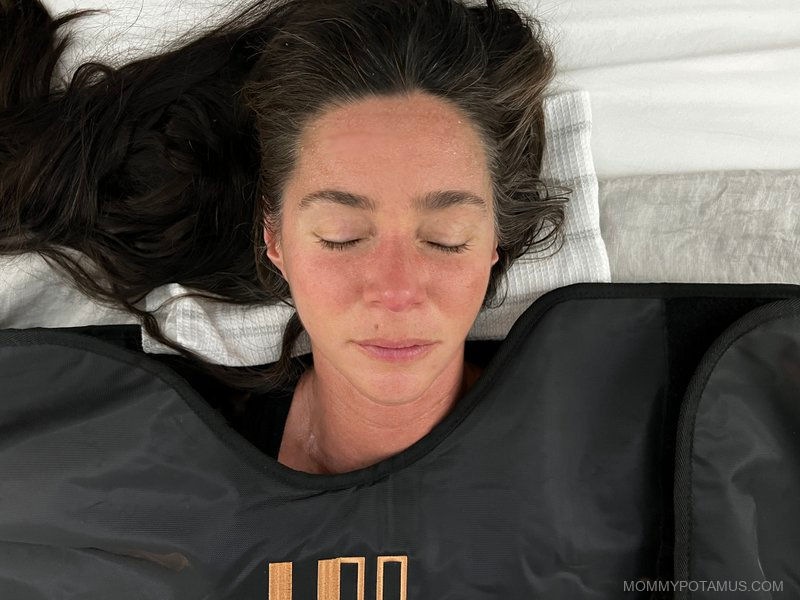
Also, when I travel I take my Heat Healer Low-EMF Infrared Sauna Blanket with me. It’s a great option for people who don’t have room for a big sauna, and/or want a more affordable option.
Click here for my full Heat Healer review.
This article was medically reviewed by Dr. Scott Soerries, MD, Family Physician and Medical Director of SteadyMD. As always, this is not personal medical advice and we recommend that you talk with your doctor.
Sources
1. World Health Organization. Warming Unit, Radiant, Infant.
2. Thornton, Joseph et. al. (2002) Biomonitoring of Industrial Pollutants: Health and Policy Implications of the Chemical Body Burden.
3. Goodman, Sarah (2009) Tests Find More Than 200 Chemicals in Newborn Umbilical Blood.
4. Sears, Margaret E. et. al. (2012) Arsenic, Cadmium, Lead and Mercury in Sweat: A Systematic Review.
5. Cohn, JR and Emmet, EA (1978) The excretion of trace minerals in human sweat.
6. Genuis, Stephen J. et. al. (2012) Human Excretion of Bisphenol A: Blood, Urine and Sweat (BUS) Study.
7. Crinnion, W (2007) Components of Practical Clinical Detox Programs – Sauna as a Therapeutic Tool.
8. Hee Lee, Ju et. al. (2006) Effects of Infrared Radiation on Skin Photo-Aging and Pigmentation.
9. Castillo, Stephanie (2015) Human Body’s Chronological and Biological Age May Differ: Why Your Breast Tissues Are Older Than The Rest of You.
10. Patrick, Rhonda (2016) Sauna Use and Building Resilience To Stress.
11. Ambra, R et. al. (2004) Characterization of the hsp70 response in lymphoblasts from aged and centenarian subjects and differential effects of in vitro zinc supplementation.
12. Sagi, Dror and Kim, Stuart K. (2012) An Engineering Approach To Extending Lifespan in C. Elegans.
13. Torigoe, T. et. al. (2009) Heat shock proteins and immunity: application of hyperthermia for immunomodulation.
14. Konopka, AR et. al. (2010) Molecular adaptations to aerobic exercise skeletal training in skeletal muscle of older women.
15. Flachsbart, Friederike et. al. (2009) Association of FOXO3A variation with human longevity confirmed in German centenarians.
16. Segal, Jeanne et. al. Stress Symptoms, Signs and Causes.
17. Geddes, Linda (2011) Saunas could heal your mood and your heart.
18. Kilpi, Eero (2015) Health Benefits of Sauna.
19. Piepmeier, Aaron T and Etnier, Jennifer L. (2015) Brain-derived neurotrophic factor (BDNF) as a potential mechanism of the effects of acute exercise on cognitive performance.
20. Laatikainen, K et. al. (1988) Response of plasma endorphins, prolactin and catecholamines in women to intense heat in a sauna.
21. Merz, Beverly (2015) Sauna use linked to longer life, fewer fatal heart problems.



